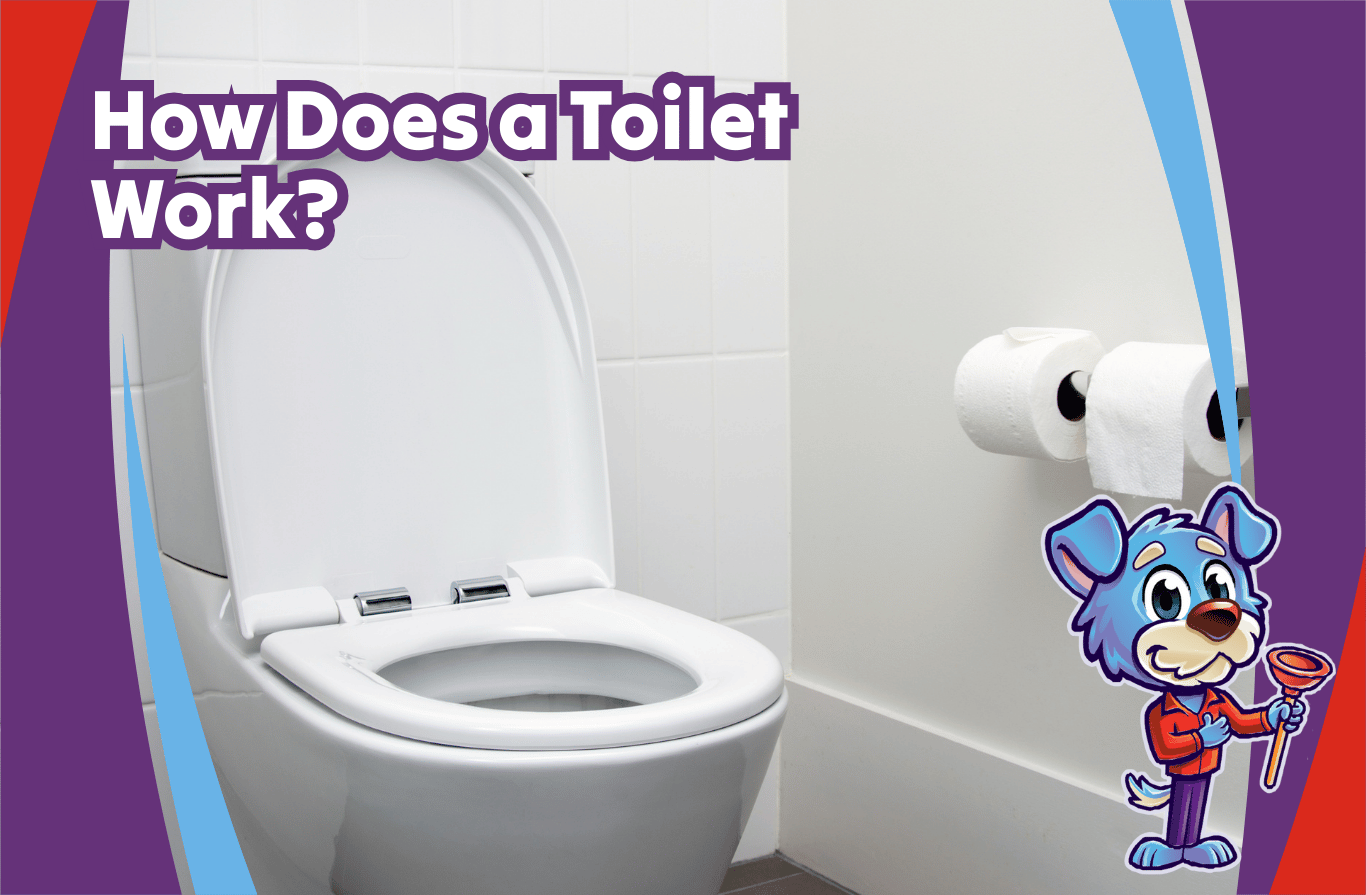How Does a Toilet Work?
Toilets are one of the most-used yet least-understood plumbing fixtures in the home. Every flush sets off a brilliant chain of mechanical and gravitational actions that we rarely think about. Yet knowing how a toilet works can help you solve issues like weak flushing, running water, or clogs without immediately calling for help.
At Trusted Plumbing & Heating, we believe that understanding your plumbing systems puts power back in your hands. So let’s break down the basics (and the not-so-basics) of what really happens when you flush.
Quick Overview: What Happens When You Flush a Toilet
If you’re short on time, here’s a brief summary of how a toilet works:
- Pressing the flush handle lifts the flapper.
- Water from the tank rushes into the bowl.
- The siphon jet and gravity force water and waste through the trap.
- The tank refills, preparing for the next flush.
This process may look simple, but it relies on precise timing and pressure for optimal efficiency.
The Flush Begins: Handle, Chain, and Flapper Action
Everything starts with the flush handle. When pressed, it triggers the lift arm inside the tank. The arm is connected to a chain, which raises the rubber flapper at the bottom of the tank. The flapper rises and stays afloat briefly, creating an opening for the water to escape into the bowl. This initial step is crucial because without it, the flushing process cannot begin.
Tank Water Rushes Into the Bowl: Rim Jets and Siphon Jet
Once the flapper is lifted, gravity sends the water stored in the tank into the toilet bowl. The flow of water is split between two outlets:
- Rim Jets: Small holes located under the rim that rinse the bowl.
- Siphon Jet: A larger, more forceful outlet at the base of the bowl that drives waste into the trapway.
Roughly 20 percent of the water is used by rim jets to clean the bowl, while the majority is directed into the siphon jet to initiate the flushing action.
The Power of Gravity and Siphon: Creating the Suction
Toilets use a gravity-assisted siphon system. As water rapidly fills the trapway, it crests the bend in the S-shaped trap and flows into the drain. This creates a siphoning action, pulling remaining water and waste from the bowl. Once air enters the trap, the siphon breaks and the flushing ends. This efficient design clears the bowl with minimal water and no moving parts in the bowl itself.
The Flapper Drops: Sealing the Tank Again
After the tank empties, the flapper drops back onto the flush valve opening. This forms a watertight seal and prevents any additional water from draining into the bowl. If the flapper fails to seal properly, it can lead to a continuously running toilet, wasting water and increasing utility bills.
The Fill Valve Activates: Refilling the Tank and Bowl
As soon as the flapper seals the flush valve, the fill valve comes into play. Connected to your home’s water supply line, the fill valve starts refilling the tank. A small refill tube directs a portion of this water through the overflow tube into the toilet bowl. This step ensures the bowl has the correct amount of standing water for the next flush while the tank is refilled simultaneously.
Bowl and Trapway Reset: Water Levels Equalize
The float mechanism in the tank controls when the fill valve shuts off. As the tank refills, the float rises until it reaches a preset level. Once this level is reached, the fill valve stops the incoming water. The bowl also stabilizes with the correct amount of water, maintaining a seal against sewer gases and preparing the system for its next use.
Inside the Toilet Tank: Key Parts and Their Roles
The toilet tank contains the essential components that drive each flush:
- Flush Handle: Initiates the flushing process.
- Lever Arm: Connects handle to the chain.
- Chain: Lifts the flapper.
- Flapper: Opens and seals the flush valve.
- Flush Valve: Releases tank water into the bowl.
- Fill Valve: Refills the tank with fresh water.
- Refill Tube: Sends water into the bowl during refill.
- Overflow Tube: Prevents overfilling.
- Float Ball or Cup: Regulates the fill valve.
Each part must be in good condition for optimal performance. Wear and tear on any of these components can lead to inefficient flushing or leaks.
Advanced Mechanisms: How Siphoning and Water Pressure Work Together
Toilets don’t rely solely on mechanical parts. They also harness physics. The siphoning action allows for waste removal without moving parts. The pressure created by the water stored in the tank provides the force required to push waste through the trap. This is why tank size matters. Smaller tanks need higher-efficiency jets or pressure-assist systems to function effectively.
Modern toilets often use just 1.28 gallons per flush, compared to older models using up to 3.5 gallons. This water efficiency is achieved through refined siphon designs and improved jet direction.
Types of Toilet Mechanisms
Understanding the mechanism type can help when choosing a toilet:
- Gravity-Fed Toilets: Most common residential model. Relies on tank height and gravity.
- Pressure-Assisted Toilets: Use compressed air for a more powerful flush. Great for commercial use.
- Dual-Flush Toilets: Offer separate flushes for liquid and solid waste to save water.
- Tankless Toilets: Use direct water line pressure, often seen in modern or compact designs.
Each type has unique flushing characteristics and maintenance requirements.
Common Toilet Problems and What Causes Them
Toilet issues often stem from wear on the tank components or blockages in the bowl or drain. Here’s a breakdown of common issues:
- Clogged Toilet: Usually caused by excessive waste or improper items flushed. Can be resolved with a plunger or auger.
- Slow Flush: Often the result of partial clogs or mineral buildup in the rim jets.
- Running Toilet: Typically due to a faulty flapper, fill valve, or float level setting.
- Wobbly Toilet: Loose mounting bolts or a worn wax seal can cause movement.
- Bubbling Toilet: May indicate a blocked vent pipe or main drain issue.
- Toilet Won’t Flush: Can result from low tank water, disconnected chains, or stuck flappers.
- Broken Flush Handle: Caused by corrosion or internal disconnection. Requires part replacement.
- Condensation on Tank: Occurs in humid conditions. Insulated tanks can help reduce this.
- Loose or Broken Toilet Seat: Often fixed by tightening or replacing bolts or the seat itself.
Why Knowing How a Toilet Works Saves You Time and Money
Understanding the inner workings of your toilet helps with:
- Diagnosing issues early before they become emergencies
- Performing small adjustments or fixes yourself
- Communicating more effectively with your plumber
While DIY fixes can be effective, unresolved problems can waste water and increase utility costs. It’s important to know when to call for help.
Call Trusted Plumbing & Heating for Expert Toilet Repairs and Plumbing Help
Toilet repairs may seem simple on the surface, but they can quickly become complex. When you’re dealing with recurring clogs, leaking tanks, or flush failures, it’s best to get professional help.
Trusted Plumbing & Heating specializes in fast, reliable plumbing solutions tailored to homeowners across King and Pierce Counties. Whether it’s a faulty flapper, water pressure issue, or a full toilet replacement, we handle it with expertise and care.
Expert Local Plumbing Services
From repairs to installations, maintenance to upgrades, including 24/7 emergencies, Trusted Plumbing & Heating has you covered. We offer expert plumbing services ranging from drain cleaning and trenchless sewer repair to emergency plumbing and directional drilling.
Our team serves Renton, West Seattle, Kent, Tacoma, and nearby areas in Washington with prompt service and quality workmanship.
Call us today at (206) 207-5399 to get a quick estimate and same-day service. We strive to offer straightforward quotes and exceptional service for every home.



